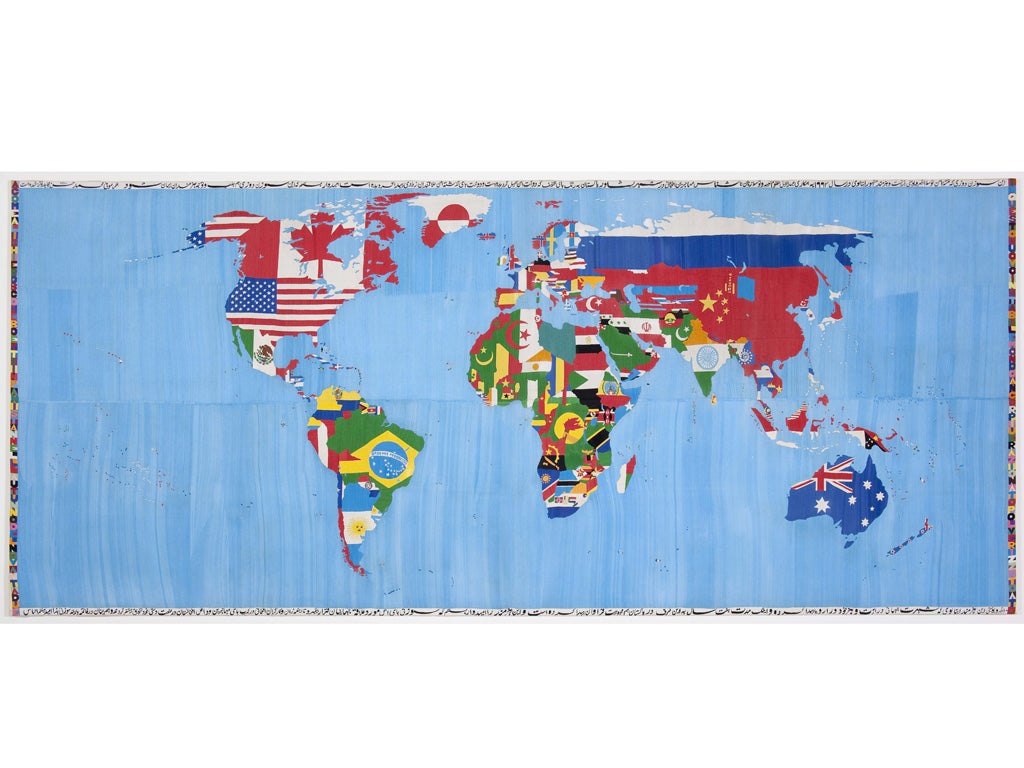A shaman and showman who had it all mapped out
Arifa Akbar looks forward to Tate Modern's retrospective of the Italian artist Alighiero Boetti

Your support helps us to tell the story
From reproductive rights to climate change to Big Tech, The Independent is on the ground when the story is developing. Whether it's investigating the financials of Elon Musk's pro-Trump PAC or producing our latest documentary, 'The A Word', which shines a light on the American women fighting for reproductive rights, we know how important it is to parse out the facts from the messaging.
At such a critical moment in US history, we need reporters on the ground. Your donation allows us to keep sending journalists to speak to both sides of the story.
The Independent is trusted by Americans across the entire political spectrum. And unlike many other quality news outlets, we choose not to lock Americans out of our reporting and analysis with paywalls. We believe quality journalism should be available to everyone, paid for by those who can afford it.
Your support makes all the difference.The Italian artist Alighiero Boetti spent a lot of time thinking about self-presentation. He loved the idea of the "double", so he re-cast himself as two people (Alighiero and Boetti), sent out postcards showing himself as twins and gave the artist a split personality – that of "divine shaman" who channelled life's profundities and "public showman" who beguiled the crowds with tricks of the eye.
Born in 1940 in Turin, he thought like a conceptual artist far beyond his time. As his career progressed, he challenged the notion that an artwork was only an artwork if it had been created by the artist's own hand. He had the idea, and he sent it out to be made by others, a concept contemporary artists such as Damien Hirst and Takashi Murakami have also adopted. The method was contentious then as now: David Hockney is the last in a long line to criticise the artist that conceives his work, but does not engage in its production.
This month, Tate Modern will bring Boetti's work to Britain in a large-scale retrospective that will explore the considerable influence he had on artists long after his death in 1994. An artwork, Boetti believed, could be authored by different people, to give it a multiple character. This belief led him to enlist friends, acquaintances, children, students, janitors, as well as unknown teams of craftspeople in Rome, and later in Afghanistan and Pakistan, to make his works.
In 1971, he bought premises in Kabul – One Hotel – to co-ordinate a lifelong project of map-making, called Mappa, but often, he did not meet the local craftsmen and women who embroidered his giant "world map" series from the beginning of the 1970s to 1994. In these maps, each country was coloured with its national flag, and as the years progressed, the maps became a geopolitical record of shifting boundaries, the formation of new countries, the dissolution of old, not least charting the independence of African states and the break-up of the Soviet Union.
His instructions on how to make the maps gave the workers some creative leeway, and were delivered though a local interpreter. A catalogue essay on this seminal stage of Boetti's career states: "It is not by accident that Boetti finds in Afghanistan the most efficient way to neutralise the spectre of authorship. Within the domain of the Islamic art and architecture of Central Asia, the dissolution of authorship and collective work are undisputed facts of a centuries-old tradition."
Other people were enlisted for a series of drawings made up of thousands of repetitive lines made by a ballpoint pen and encoded with mysterious codes, words, and puns. Play, and the concept of playfulness, was a major preoccupation for Boetti. Some of this was literal – he made jigsaw puzzles and domino games for children. A more conceptual playfulness came with sculptures such as Yearly Lamp, in 1966, comprising a lightbulb in a box that lit up randomly for 11 seconds a year. He also wrote letters to friends and notable figures dead and alive – Marcel Duchamp and Bruce Nauman – with deliberately incorrect addresses on the envelopes, which he got back after they had travelled around the world.
Lynne Cooke, the curator at Reina Sofia in Madrid, worked with Boetti in the last five years of his life. Alongside the idea of play, she says, was his enduring fascination with time. In a work entitled 16 Dicembre 2040 – 11 Luglio 2023, Boetti marked the 100th anniversary of his birth, alongside a forecast of the day of his death (11 July 2023). He overshot by quite a margin on the latter date, though his work and influence lives on.
Join our commenting forum
Join thought-provoking conversations, follow other Independent readers and see their replies
Comments